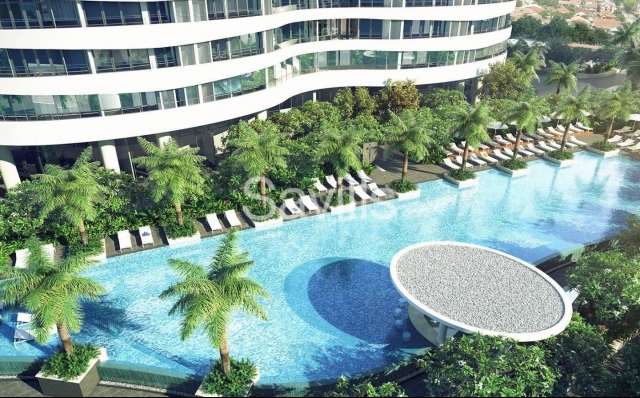|
Tourism growth presents opportunities for hospitality
market
The growth of tourism is
creating opportunities for the hospitality market, especially the mid-end and
high-end segments, according to Savills’ latest review.

In 2016, the total rated travel accommodation supply in
Vietnam was up 18 per cent year-on-year to 420,000 hotel rooms, commensurate
to tourism industry development.
Enhanced tourist flows are creating more opportunities
for the hotel market, especially in the upper-mid to high-end segments.
From 2013 to 2016, the supply of four and five-star
hotels increased 20 per cent on average to meet international tourist demand
for upscale resorts and luxury accommodation.
Sub-markets
As major economic hubs, Ho Chi Minh City and Hanoi
attract the most tourists. Meetings-Incentives-Conventions-Exhibitions (MICE)
and business travelers accounted for over 40 per cent of total international
arrivals to Vietnam.
In 2016, there were 5 million visitors to Ho Chi Minh
City and 4 million to Hanoi.
Previously the only international points of entry by
air, arrivals in Ho Chi Minh City and Hanoi are now being marginally undercut
by growth in capacity and the number of direct flight to other key cities.
On the other hand, increased ease of travel has made
Vietnam far more attractive. Emerging coastal destinations such as Da Nang,
Nha Trang, and Phu Quoc Island are becoming more competitive, with direct
international flights.
Hanoi remains the gateway for tourists to northern
provinces and likewise Ho Chi Minh City remains the gateway to Mekong Delta
provinces, but the central region is becoming increasingly self-reliant.
In 2016, Vietnam’s resort cities and islands
outperformed Ho Chi Minh City and Hanoi with higher international inbound
growth rates.
A tropical island location makes Phu Quoc an attractive
destination and a new alternative for international travelers, with an
arrival growth rate of 40 per cent.
Da Nang, at over 30 per cent, and Nha Trang at 23 per
cent also exceeded the international arrival rates of Ho Chi Minh City at 10
per cent and Hanoi at 19 per cent.
Ho Chi Minh City has the largest hotel supply in
Vietnam, with approximately 16,000 three- to five-star rooms, 70 per cent
more than Hanoi.
In 2016, both had similar occupancy rates of
approximately 70 per cent, but future supply rates will diverge.
Over the next three years, Ho Chi Minh City expects
3,500 new rooms, a 22 per cent increase. Pressure will be higher in Hanoi,
with future supply accounting for up to 50 per cent of current stock.
Nha Trang has the largest hotel supply among coastal
cities, with over 12,000 three- to five-star rooms and the highest occupancy
rate.
In 2016, the city had 1.2 million international
arrivals, which was 30 per cent lower than Da Nang.
The average Length of Stay (LOS) varies among popular
destinations. In 2016, the international tourist LOS in Nha Trang was 3.5
days, compared to 2.8 days in Da Nang and 2.6 days on Phu Quoc.
Da Nang appeals to both domestic and international visitors,
with an international airport and location along the Central Heritage Road,
which comprises Hoi An ancient town, the My Son Sanctuary, the Imperial City
of Hue, and Phong Nha caves. However, this ease of access also diminishes Da
Nang’s ability to increase tourists’ LOS.
Phu Quoc is an ideal destination for high-end
hospitality, and as of the fourth quarter of 2016 the five-star segment
accounted for 71 per cent of the 2,500 three- to five-star hotel rooms.
However, as an early-developed market, a large future
supply may challenge developers to improve performance.
Tourism growth

Vietnam is a rapidly growing Southeast Asian tourism
destination. However, inbound travelers are less than half of those visiting
the most popular ASEAN locations of Thailand and Malaysia. This gap
represents significant potential.
Inbound travelers have tripled in the last decade and a
26 per cent year-on-year increase in 2016 saw Vietnam outperforming other
regional destinations.
According to the Ministry of Culture, Sports and
Tourism, there were approximately 10 million international arrivals in
Vietnam in 2016.
This growth is expected to continue, with approximately
18 million annual visitors anticipated by 2030.
China and Russia are Vietnam’s fastest growing inbound
source markets. Russia has a tourist visa exemption and its population
prefers Vietnam for holidays, particularly because of its lower costs
relative to other destinations in the region.
Even in the wake of sanctions and a depressed Ruble,
Russian arrivals to Vietnam have steadily increased over the past few years.
The growing middle class in China is creating greater
outbound travel demand, especially to more affordable ASEAN
destinations.
In 2016, Vietnam had a combined 2.7 million business
travelers and tourists from China, a 50 per cent increase over 2015.
China-based ASEAN inbound visitors are forecast to double over the next ten
years, according to Goldman Sachs in 2015.
The country’s rich geographic and topographic diversity
and local micro climates support a variety of tourism appeals.
Fast-growing increases in household and personal income
over the past five years have contributed to a 15 per cent expansion in
Vietnam’s domestic tourism.
Low-cost airlines have been a growth catalyst, and from
2014 to 2016 Vietjet Air increased its fleet size from 18 to 45 aircraft.
To further encourage growth in domestic tourism, the
government approved a decree allowing Vietnamese to gamble in casinos under
certain conditions.
While gambling remains labelled by the National
Assembly as a “social evil”, this new legislation is indicative of the leadership’s
commitment to supporting tourism growth and widening regional
competitiveness.
VN
Economic Times
|
Thứ Ba, 18 tháng 4, 2017
Đăng ký:
Đăng Nhận xét (Atom)
Không có nhận xét nào:
Đăng nhận xét